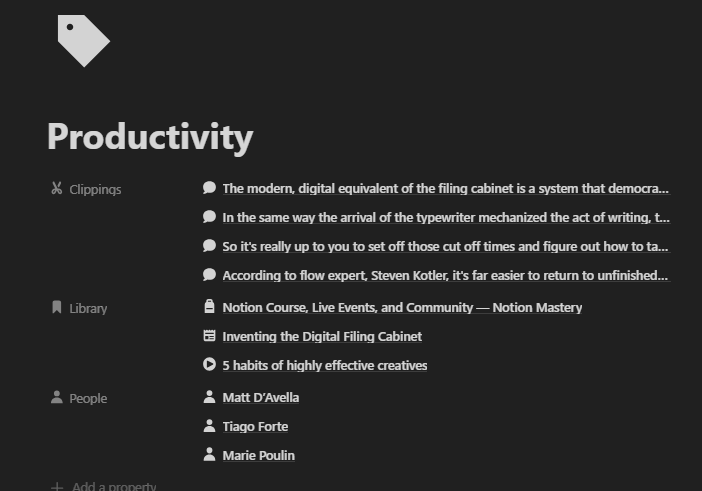How I Use Notion for Personal Knowledge Management: Organise
Disclaimer: Please note that some links in this article may contain affiliate links. This means that I may earn a commission if you make a purchase or sign up through those links at no extra cost to you. I only recommend products and services that I have personally used and found valuable.
In part one I looked at why I use a personal knowledge management (PKM) system and why I chose Notion as the tool for that system. In part 2, I discussed how I implemented the first aspect of Tiago Forte’s C.O.D.E framework; Capture into the system. In this part we’ll discuss how and why we organise what’s captured within the system.
“The moment you first encounter an idea is the worst time to decide what it means. You need to set it aside and gain some objectivity” - Tiago Forte, Building a Second Brain
This is why I like to separate the capture and organizing process. Frictionless capture, lets you stay present with your work. Organizing later, gives you a more objective view of what really resonates and can add value. This is where the second layer of curation takes place. While we might aim to be more selective in our capture process we don’t want to spend too much time on deciding whether or not something is worth holding on to. Capture it and circle back to it when you’ve got time to organize your notes and ideas. If those notes still resonate or seem valuable after that bit of time passes, they’re definitely worth keeping and spending the time to organize.
My primary goal of organizaing the knowledge I’m capturing is to put it to good use. I do this by relating it to an action; a piece of content in my content database, an incoming project in my projects database or a task from my task database. Tiago Forte once said, “your time and energy are much better spent thinking about how the contents of your notes can be used to advance your projects and goals”, “instead of organizing ideas according to where they come from, I recommend organizing them according to where they are going.” Relating your content to a piece of your work is the best way to achieve this.
If the main purpose of organizing is to relate what we capture to our own work is their much point organizing further? Is adding additional tags and metadata really necessary? Organizing around action is the goal, anything else is a bonus but additional tags definitely have their uses. Relating content to tags in your tags database. In a blog post on the topic of tagging, Tiago Forte outlined how tagging can provide “an alternative lens through which you can view your knowledge.” It allows you to see a cross-section of your notes from a different perspective. These different cross-sections are invaluable. Creating relations based on action is great but ultimately it silos your knowledge. Different cross sections allow you to make connections in different places and hopefully create more interesting insights and inspire new ideas.
Beyond relating items to a tag in my tags database or to a person in my people database, in the interest of time (and sanity) I don’t tend to add more metadata. Populating a multi-select field with 10 additional keywords for a 20 word quote might not be the best use of my time. Ultimately, any organisation should significantly improve your ability to either search for that note or make connections to other notes. Keywords tend to repeat the key terms in the notes you’re saving anyway, so there’s no real bonus to searchability. Where you can lose out is in connecting ideas. If you use keywords to apply broader themes or emotions to your notes you may be able to make some pretty interesting connections, in unexpected places. The chances of making those connections aren’t worth the extra time and effort it takes to organize them. This is one of my favourite use cases for Notion AI. Ask AI to create those keywords for you, it might not be as useful compared to doing it yourself but you can get pretty close without spending any time.
I’m working on an automation in make.com to get the output of the AI prompt to populate a multi-select field in Notion. I haven’t managed to do it in a way that doesn’t create a multi-select field with hundreds and hundreds of values. If I ever crack it fully, I’ll update this post with the details.
Update - Notion have just launched an new AI feature that can automatically populate multi-select fields. Here’s the AI prompt I use:
“Suggest a MAXIMUM of 8 ONE OR TWO word keywords for this page content. The purpose of these keywords is to improve the page’s ability to surface in Notion search results and to highlight similar themes between different Notion pages. Keywords should include broad themes and emotions. Prioritize using existing keywords where possible. In terms of formatting CAPITALIZE EACH INDIVIDUAL WORD AND SEPARATE THEM WITH A SPACE.”
As an aside, I’ve noticed I get better results with AI models when capitalizing key aspects of the prompt. Unfortunately, Notion AI struggles to abide by formatting instructions (like capitalization) but on the whole this is a really nice AI feature
Items captured in my system will surface an inbox view of the respective database. I have an inbox for most databases in my system, clippings, library, tasks etc. The filter for the inbox view is super simple. All items where the categorized checkbox is unchecked display here.
You could set up a filter so that all items without specified criteria display in the inbox view. So for example, all items that don’t have a related author and tag display here, so once you add that data they disappear. However, in my experience, not all resources are created equal. Different resources would have different criteria to be considered categorized. This is why I use a checkbox property is used in this view. Using a checkbox property allows you to add as little or as much data to what you capture before considering it categorized.
The limitation of the categorized checkbox is when you are adding resources within their context. For example, if you add a resource within a project you are adding that resource with the context that it relates to that project. Therefore, we could consider that resource categorized and not one we would like to surface in Inbox views. To resolve this we add an additional filter to linked database where the Categorized checkbox is checked. This is a forcing filter, so that when you add resources within their context (like adding resources within a project) they are considered categorized without a manual check. All relevant views in my system have this filter applied. If you want to use or adapt my organization system, you can use this filter if you are creating additional database views that give context to your database items.
Another tip is to set up a declutter or organisation page with all of your different inboxes, from all of your different databases. Then you can allocate whatever time you need to go to that page and simply organize what you’ve captured. For me, this is 15 minutes every couple of days. This is a pretty simple concept, but it’s really useful. Before this I was jumping to a Library Page to organize my inbox there and then to a Tasks page to categorize anything in that box. Orientate around action. Create the database views in one place dedicated for that context. This is the organisation page, the page I visit to organise.
I’ve touched on this already, and mentioned it in previous posts but I want to dive into why using separate databases and relations between those databases is a key part of the organization of this system. This is something I picked up from Notion expert; Marie Poulin a while ago. When starting out, you might be inclined to have separate Select properties for tags in your Clippings and Library databases for example. While I still use (AI powered) multi-select properties for some more granular tagging, relating to a tag in a dedicated Tags database is much more powerful. Let’s use this example; you capture a quote in your Clippings database and you relate that quote to a tag in your Tags database. When you go to the related tag’s page you see all of the related items within the context of what they have in common (their relation to the tag). So you can see all of the quotes that fall under that tag or theme, books or other library items related to it - or even the work you’ve created related to that theme. Organizing primarily by relations to your different databases powers the connections between what you capture.
Organiation is the key to unlocking your knowledge and making use of it. If you’re interested in giving my knowledge management template a try, there’s more information available below.














